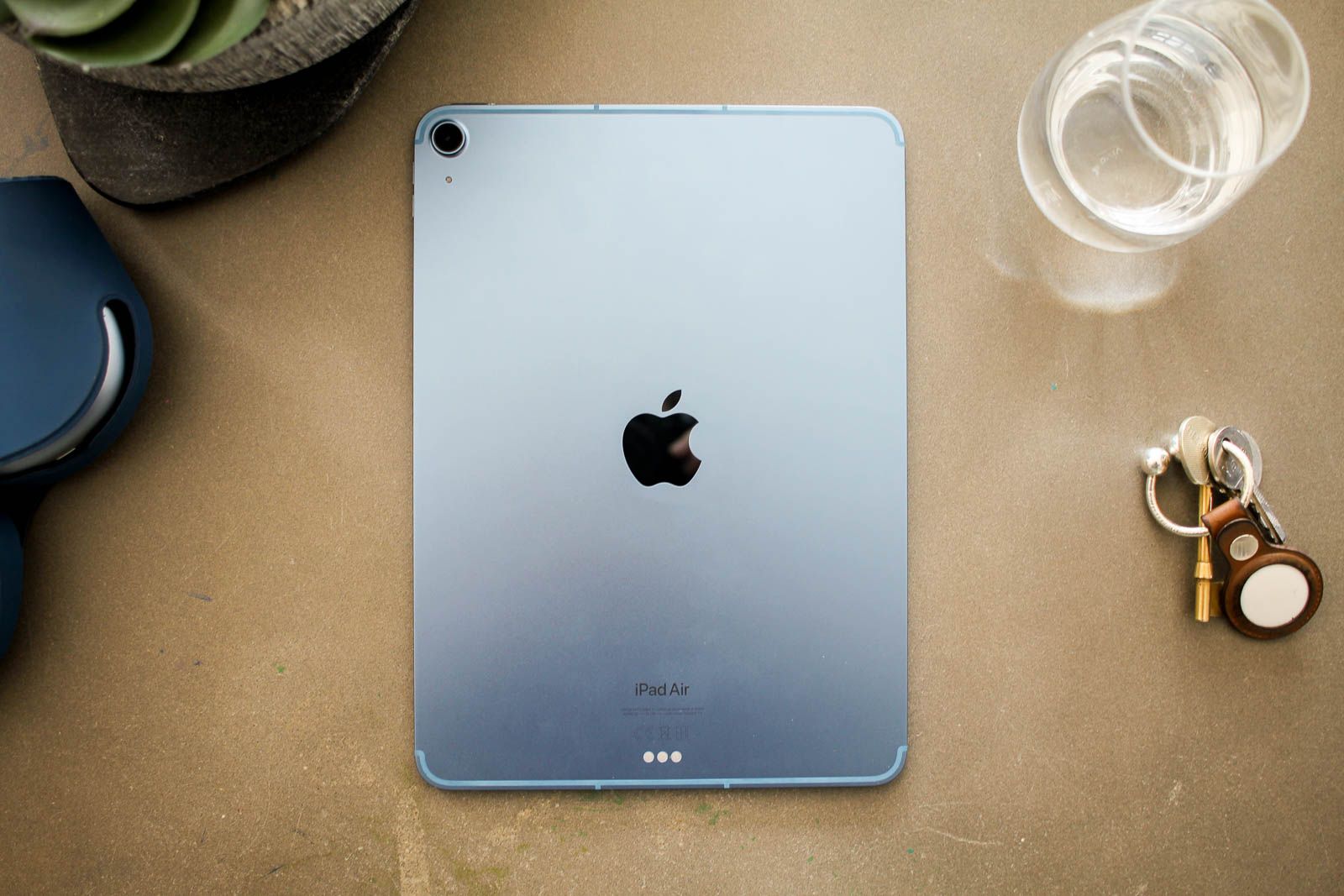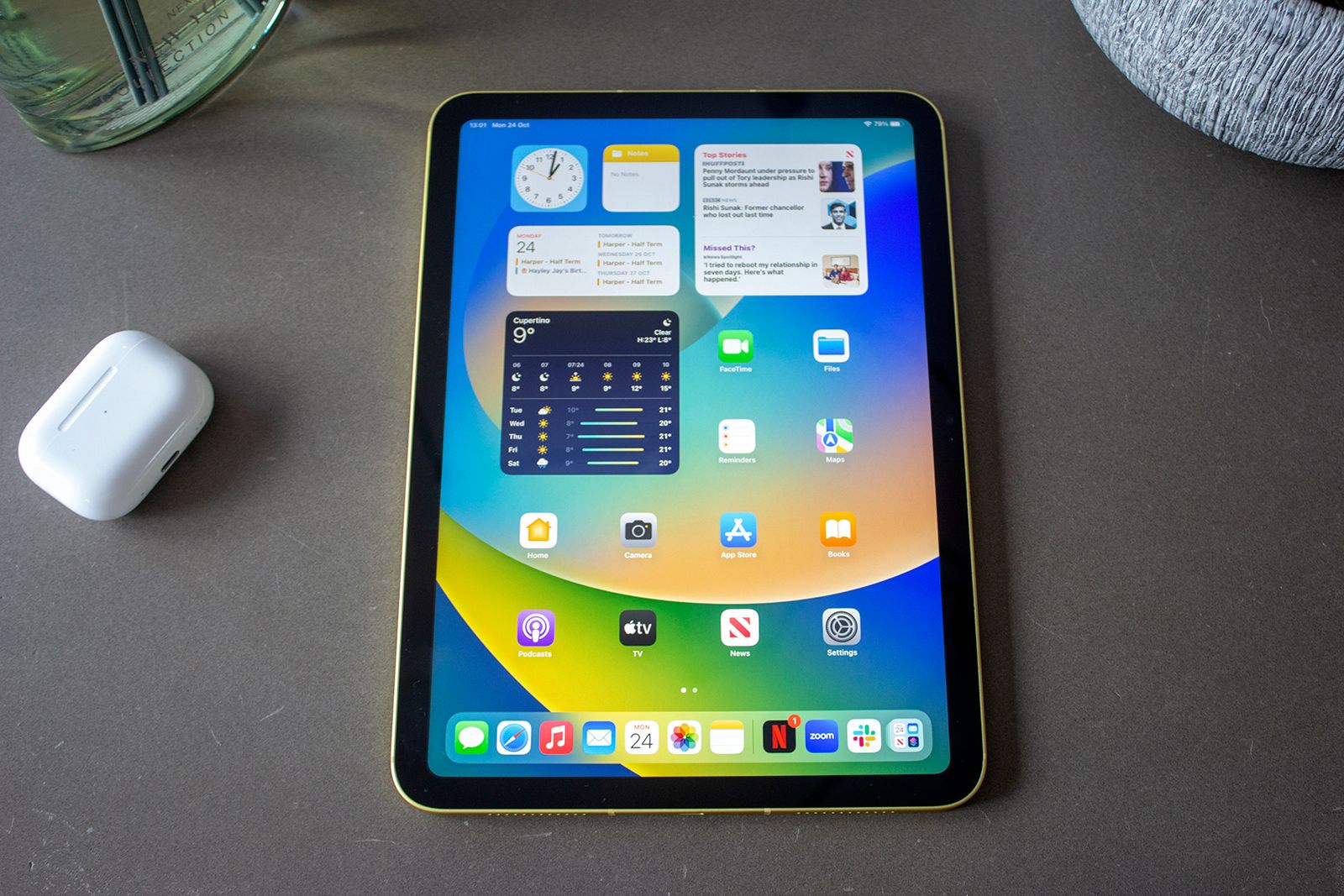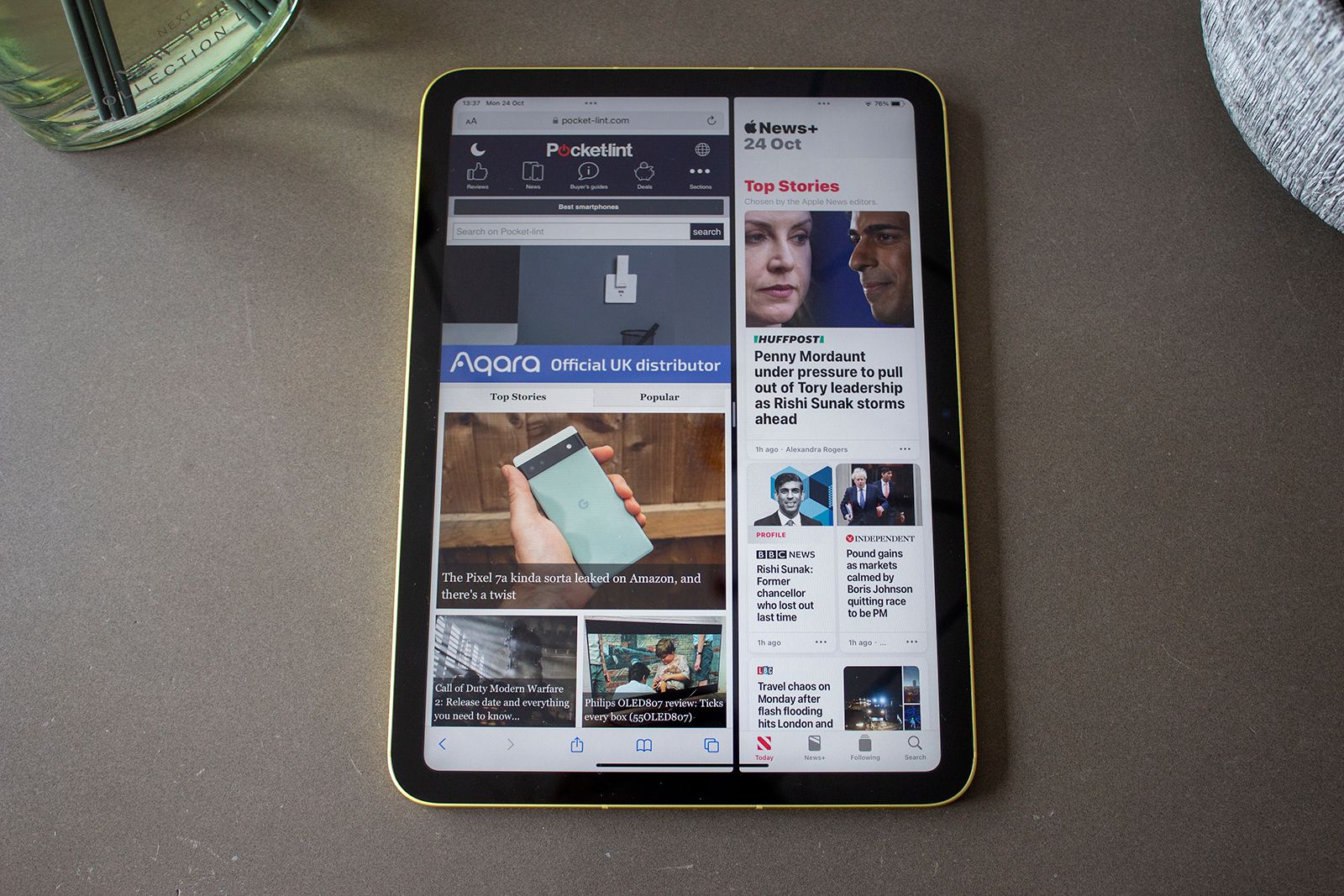-
Pocket-lint / Apple
Apple iPad (2022)
Our top choice
The iPad (10th generation) is a perfect blend of features and value for money, and with its upgraded design, it’s likely to become the new go-to iPad for most people.
Pros- Great design upgrades
- Solid performance
- Excellent features
Cons- No Stage Manager
- No fully laminated display
-
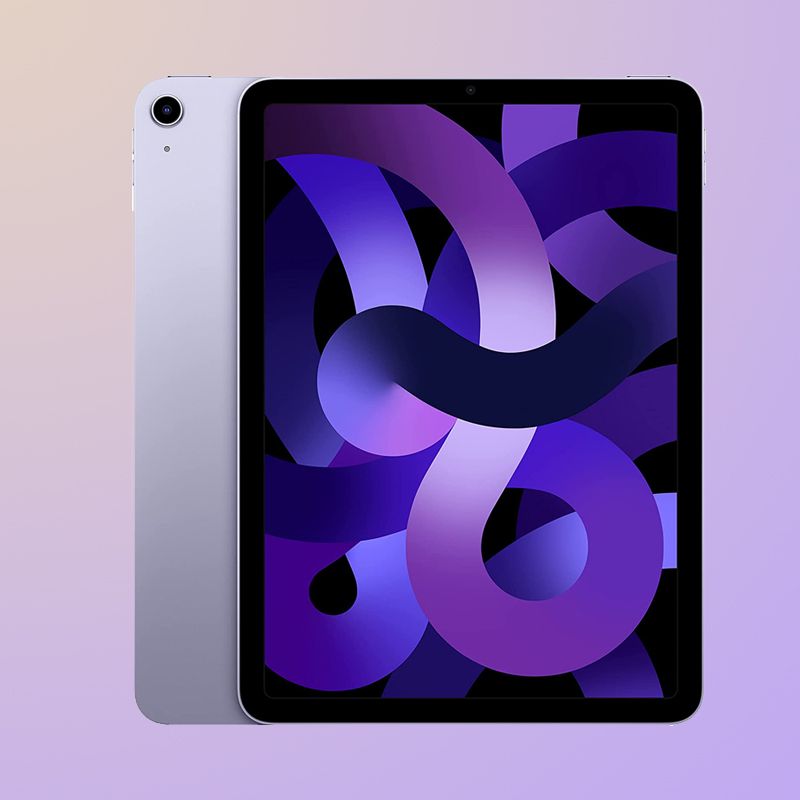
Pocket-lint / Apple
Apple iPad Air (2022)
Excellent alternative
The Apple iPad Air went from being a great slate to an even greater one with this model. The 2022 Air is even faster in performance, whilst offering a fantastic design.
Pros- Excellent performance
- Great front camera
- Apple Pencil (2nd gen) support
Cons- No Face ID
- Accessories expensive
Apple revealed the 10th generation of the entry-level iPad in October 2022, offering a redesign, chip upgrade and a colour refresh over its predecessor. The redesign of the entry level iPad sees it finally ditch the Home Button and opt for a very similar look to the iPad Air, compared to the older design still found on the 9th generation iPad. The price has also increased, making the decision between the entry-level iPad and the iPad Air that little bit harder.
With that in mind, we’ve run up the differences between the iPad (10th generation, 2022) and the iPad Air (2022) to help you work out what the differences are and which makes the most sense to buy. We’ve also got a full iPad comparison feature comparing all iPad models, and a feature comparing the iPad (10th generation) and iPad (9th generation) in case you want more detail on the lower end iPad models.
Price, availability and specs
Let’s first start with the price as this may be the deciding factor between these two models, depending on your budget. The iPad (10th generation) hit shelves on 26 October 2022. It starts at $449 in the US and £499 in the UK for the Wi-Fi only model and it is available globally. The iPad Air (2022) meanwhile, starts at £669 in the UK and $599 in the US. That’s again for the Wi-Fi only model. Both the iPad (10th gen) and the iPad Air come in Wi-Fi and Cellular models too though.
The iPad (10th generation) comes in four colour options of Blue, Pink, Yellow and Silver. The colours are lovely and bold so make for a striking tablet. The iPad Air meanwhile, also comes in a number of colour options but they are more pastel colours and therefore more muted than the iPad, making for a slightly more serious and professional look. It comes in five options including Purple, Pink, Blue, Space Grey and Starlight.
You can see a quick rundown of the specs between the iPad (10th generation) and the iPad Air below, but if you want a deeper dive into how these two tablets differ, keep reading.
-
Apple iPad (2022) Apple iPad Air (2022) Storage 64 / 256GB 64 / 256GB CPU Apple A14 Bionic Apple M1 chip Operating System iPadOS 16 iPadOS 16 Battery Up to 10 hours Up to 10 hours Ports USB-C USB-C Camera (Rear, Front) 12MP f/1.8 rear, 12MP f/2.4 front landscape 12MP f/1.8 rear, 12MP f/2.4 front vertical Display (Size, Resolution) 10.9-inch Liquid Retina, 2360 x 1640 pixels, 264ppi, 500nits 10.9-inch Liquid Retina, 2360 x 1640 pixels, 264ppi, 500nits Measurements 248.6 x 179.5 x 7mm, 477g 247.6 x 178.5 x 6.1mm, 461g Colors Yellow, Blue, Pink, Silver Blue, Purple, Pink, Starlight, Space Grey
Design and build
The Apple iPad (10th generation) and the iPad Air are virtually identical in terms of their designs. Both opt for uniformed bezels around their displays, aluminium bodies with flat edges and they both have a power button at the top with Touch ID built in. You’d be hard pressed to tell the two tablets apart in terms of design in fact, with only really the colours giving the two ranges away.
The two devices also both have a single camera lens in the top left corner of the rear, a USB-C charging port flanked by speakers at the bottom and a Smart Connector. The iPad (10th gen) has its Smart Connector on the left edge, while the iPad Air has its Smart Connector on the rear.
The other difference between the two models in terms of design is the FaceTime HD front camera is positioned on the right edge of the iPad (10th generation), which makes it more useful for video calling when held horizontally. The iPad Air meanwhile, has the front camera at the top of the display when held vertically. In terms of measurements, the iPad (10th generation) is slightly larger – fractionally mind – and it is 1mm thicker too. It is also slightly heavier.
Display
Pocket-lint
The Apple iPad (10th generation) and the iPad Air both come with a 10.9-inch display offering a 2360 x 1640 pixel resolution. It means both devices have a pixel density of 264ppi and detail is lovely and crisp on both, while colours are punchy and vibrant.
The two tablets opt for a Liquid Retina Display and they both have a maximum brightness of 500nits. Apple’s True Tone technology is also supported on both devices and they both have a fingerprint-resistant oleophobic coating.
There are a couple of differences in the iPad (10th gen) and iPad Air displays though. The iPad Air offers a P3 wide colour display, while the iPad (10th gen) is RGB so you get a slightly wider colour spectrum on the iPad Air. The iPad Air also has a fully laminated display and an anti-reflective coating, which you do notice in use compared to the iPad (10th generation).
Hardware and battery
The Apple iPad (10th generation) runs on the A14 Bionic chip, which offers a 6-core CPU and a 4-core GPU. There’s a 16-core Neural Engine on board too. The iPad Air meanwhile, runs on the M1 chip, which offers an 8-core CPU and 8-core GPU. It has a 16-core Neural Engine too, but there’s 8GB of RAM on board as well. The iPad Air also has a Media Engine on board. There’s a huge amount of power in the iPad Air so while the iPad (10th generation) is a very capable tablet, the iPad Air will outperform it in some cases.
In terms of other specifications, both the iPad (10th generation) and the iPad Air have a 12-megapixel rear camera on board, with an f/1.8 aperture, 5x digital zoom and Smart HDR 3 for photos. They also both offer up to 4K video recording up to 60fps. On the front, both tablets have a 12-megapixel camera with f/2.4 aperture, a Retina Flash and features like Centre Stage. The iPad (10th generation) has its front camera presented in a landscape orientation as we mentioned though and this is more useful when it comes to video calling.
These two tablets also both have the same battery promise though, with up to 10 hours of watching video or up to 9 hours surfing the web and both have USB-C for charging. Storage options are the same too, with both the iPad (10th generation) and the iPad Air offered in 64GB and 256GB options so there really is very little difference between these two devices in terms of the core specifications.
Elsewhere, the iPad Air is compatible with the 2nd generation Apple Pencil, while the iPad (10th generation) is only compatible with the first generation Apple Pencil and you’ll also need an adapter to charge it as the Apple Pencil (1st generation) is charged via Lightning.
Software
Pocket-lint
Both the iPad (10th generation) and the iPad Air will run on iPadOS 16 so the experience will be familiar across both devices. It’s a great operating system with access to thousands of apps, all of which are optimised for iPad and its larger display so you get a great user interface.
The iPad Air offers a couple of extra features thanks to the extra power under its hood, such as Stage Manager, which the iPad (10th generation) doesn’t offer, but most features transfer across both models, including fantastic multi-tasking. You can read our iPad tips and tricks feature for all the cool things you can do on both the iPad Air and the iPad (10th generation).
Conclusion
The Apple iPad (10th generation) and the iPad Air feature a very similar design, along with the same size display, same storage options, same battery and the same cameras so it’s a great choice for most people.
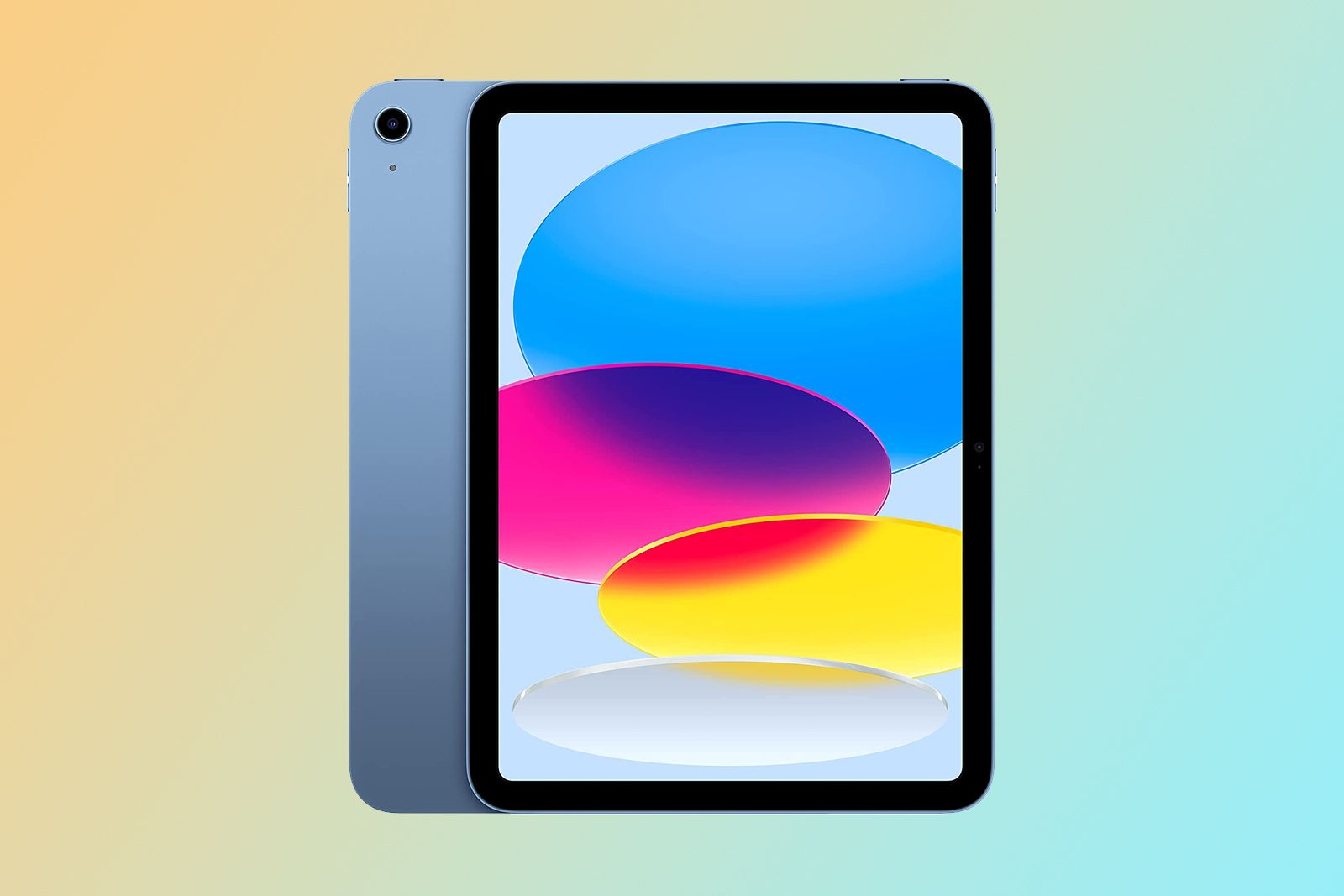
Apple iPad (2022)
Our top choice
The iPad Air has a more powerful processor under its hood, and it comes with some extra features, like Stage Manager, as well as compatibility with the 2nd generation Apple Pencil and the Smart Keyboard Folio. The Air’s display also has an anti-reflective coating and fully laminated display, which is beneficial in use.
Overall, on paper, the iPad (10th generation) makes a lot of sense and for many, it will be the most obvious choice between these two devices. Some will want the extra power – of which the M1 chip offers in abundance – but for others, the iPad (10th generation) will be the one to buy. The Air is an excellent middling device bridging the entry-level iPad and the iPad Pro models though so if you want a little more but don’t want to pay Pro prices, the Air is a brilliant option.
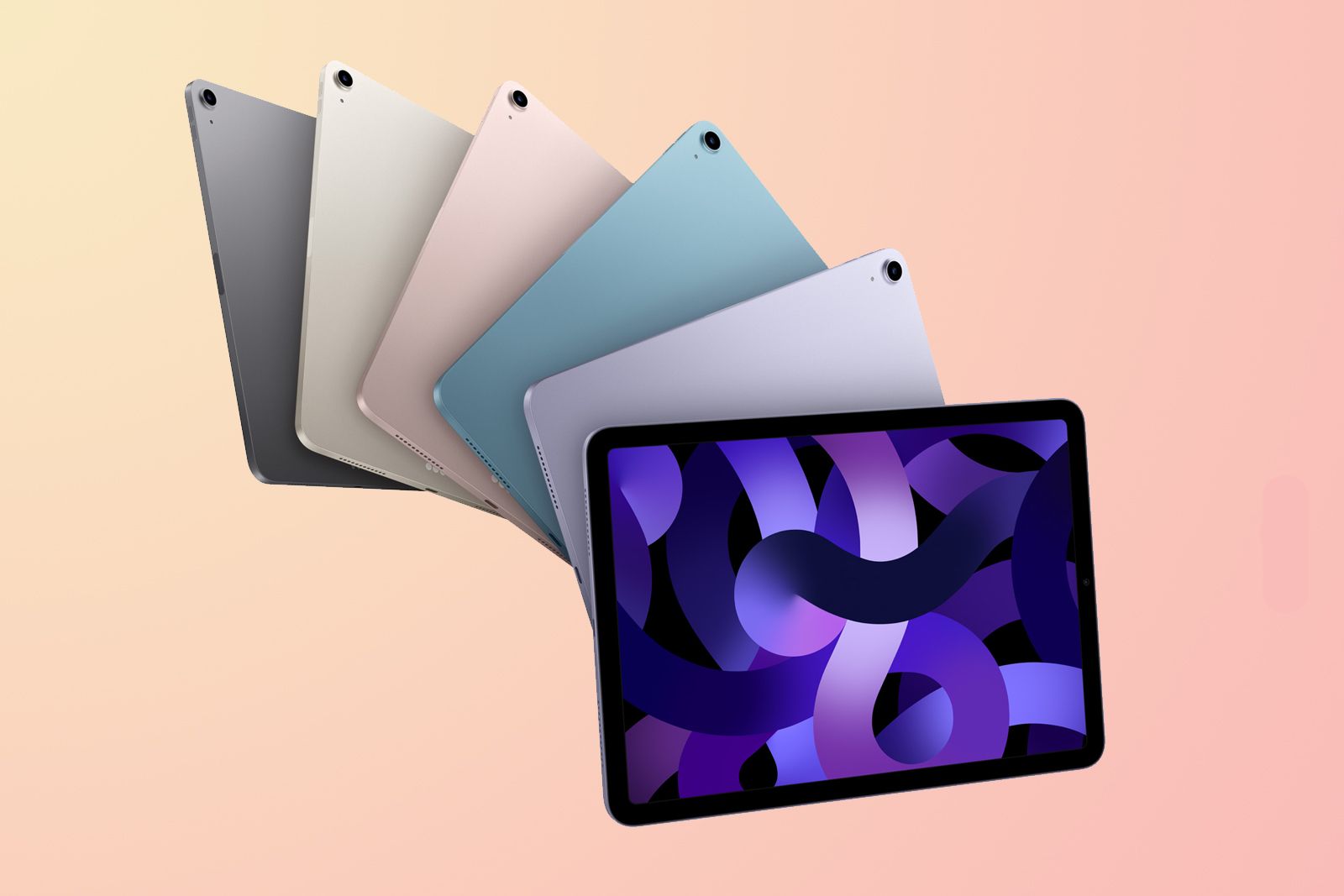
Apple / Pocket-lint
Apple iPad Air (2022)
Excellent alternative
You can read our full iPad Air (2022) review and read our full iPad (10th generation, 2022) review for a full rundown on both models.
Trending Products

Cooler Master MasterBox Q300L Micro-ATX Tower with Magnetic Design Dust Filter, Transparent Acrylic Side Panel, Adjustable I/O & Fully Ventilated Airflow, Black (MCB-Q300L-KANN-S00)

ASUS TUF Gaming GT301 ZAKU II Edition ATX mid-Tower Compact case with Tempered Glass Side Panel, Honeycomb Front Panel, 120mm Aura Addressable RGB Fan, Headphone Hanger,360mm Radiator, Gundam Edition

ASUS TUF Gaming GT501 Mid-Tower Computer Case for up to EATX Motherboards with USB 3.0 Front Panel Cases GT501/GRY/WITH Handle

be quiet! Pure Base 500DX ATX Mid Tower PC case | ARGB | 3 Pre-Installed Pure Wings 2 Fans | Tempered Glass Window | Black | BGW37

ASUS ROG Strix Helios GX601 White Edition RGB Mid-Tower Computer Case for ATX/EATX Motherboards with tempered glass, aluminum frame, GPU braces, 420mm radiator support and Aura Sync


